Laser-Induced Biochar Formation through 355 nm Pulsed Laser Irradiation of Wood, and Application to Eco-Friendly pH Sensors
Abstract
:1. Introduction
2. Materials and Methods
2.1. UV Pulsed 355 nm Laser System
2.2. Lignin in Wood
2.3. Fabricaton of Biochar
2.4. Appying Organic Polymer-Based Sensor to Agriculture
3. Results and Discussion
3.1. Graphitic Pattern Formed on Wood
3.1.1. Morphology
3.1.2. pH Sensor
4. Conclusions
Supplementary Materials
Author Contributions
Funding
Acknowledgments
Conflicts of Interest
References
- Lin, J.; Peng, Z.; Liu, Y.; Ruiz-Zepeda, F.; Ye, R. Laser-induced porous graphene films from commercial polymers. Nat. Commun. 2014, 5, 5714. [Google Scholar] [CrossRef]
- Chyan, Y.; Ye, R.; Li, Y.; Singh, S.P.; Arnusch, C.J.; Tour, J.M. Laser-Induced Graphene by Multiple Lasing: Toward Electronics on Cloth, Paper, and Food. ACS Nano 2018, 12, 2176–2183. [Google Scholar] [CrossRef]
- Ma, Y.W.; Kang, M.S.; Park, C.; Hong, S.M.; Lee, S.M.; Shin, B.S. Fabrication of polyimide spheres using a pulsed laser at 355 nm. Appl. Phys. A 2016, 122, 122. [Google Scholar] [CrossRef] [Green Version]
- Li, L.; Zhang, J.; Li, Y.; Gao, C. High-Performance Pseudocapacitive Microsupercapacitors from Laser-Induced Graphene. Adv. Mater 2016, 28, 838–845. [Google Scholar] [CrossRef]
- Peng, Z.; Ye, R.; Mann, J.A.; Zakhidov, D.; Li, Y. Flexible Boron-Doped Laser-Induced graphene Microsupercapacitors. ACS Nano 2015, 9, 5868–5875. [Google Scholar] [CrossRef]
- Jeong, S.Y.; Ma, Y.W.; Lee, J.U.; Je, G.J.; Shin, B.S. Flexible and Highly Sensitive Strain Sensor Based on Laser-Induced Graphene Pattern Fabricated by 355 nm Pulsed Laser. Sensors 2019, 19, 4867. [Google Scholar] [CrossRef] [Green Version]
- Lee, J.U.; Ma, Y.W.; Jeong, S.Y.; Shin, B.S. Direct Fabrication of Ultra-Sensitive Humidity Sensor Based on Hair-Like Laser-Induced Graphene Patterns. Micromachines 2020, 11, 476. [Google Scholar]
- Ye, R.; Chyan, Y.; Zhang, J.; Li, Y.; Han, X.; Kittrell, C. Laser-Induced Graphene Formation on Wood. Adv. Mater 2017, 29, 1702211. [Google Scholar] [CrossRef]
- Easton, E.B.; Fruehwald, H.M.; Randle, R. Probing the degradation of carbon black electrodes in the presence of chloride by electrochemical impedance spectroscopy. Carbon 2020, 162, 502–509. [Google Scholar] [CrossRef]
- Selective, S.N. Carbon Material Engineering for Improved MEMS and NEMS. Micromachines 2019, 10, 539. [Google Scholar]
- Cheng, C.H.; Lehmann, J.; Thies, J.E.; Burton, S.D.; Engelhard, M.H. Oxidation of black carbon by biotic and abiotic processes. Org. Geochem. 2006, 37, 1477–1488. [Google Scholar] [CrossRef]
- Park, J.H.; Choppala, G.K.; Bolan, N.S. Biochar reduces the bioavailability and phytotoxicity of heavy metals. Plant Soil 2011, 348, 439–451. [Google Scholar] [CrossRef]
- Webber, K.; Quicker, P. Properties of biochar. Fuel 2018, 217, 240–261. [Google Scholar] [CrossRef]
- Ippolito, J.A.; Laird, D.A.; Busscher, W.J. Environmental Benefits of Biochar. J. Environ. Qual. 2012, 41, 967–972. [Google Scholar] [CrossRef] [Green Version]
- Medvitz, A.; Sokolow, A. Can we stop farmland losses? Population growth threatens agriculture, open space. Calif. Agric. 1995, 49, 11–17. [Google Scholar] [CrossRef] [Green Version]
- Dubey, A.K.; Singh, D.; Rajput, P.S.; Kumar, Y.; Verma, A.K.; Chandraker, S.K. Effect of NPK on plant growth, yield and quality of Capsicum (Capsicum annum L.) cv Swarna Under Shade Net Condition. Int. J. Curr. Microbiol. App. Sci. 2017, 6, 1085–1091. [Google Scholar]
- Schachtman, D.P.; Reid, R.J.; Ayling, S.M. Phosphorus Uptake by Plants: From Soil to Cell. Plant Physiol. 1998, 116, 447–453. [Google Scholar] [CrossRef] [Green Version]
- Yusof, K.M.; Isaak, S.; Rashid, N.C.A.; Ngajikin, N.H. NPK Detection Spectroscopy on Non-Agriculture Soil. J. Teknol. 2016, 78, 227–231. [Google Scholar]
- Duncan, E.G.; O’Sullivan, C.A.; Roper, M.M. Yield and nitrogen use efficiency of wheat increased with root length and biomass due to nitrogen, phosphorus, and potassium interactions. J. Plant Nutr. Soil Sci. 2018, 181, 364–373. [Google Scholar] [CrossRef]
- Wang, Z.; Li, S. Effects of Nitrogen and Phosphorus Fertilization on Plant Growth and Nitrate Accumulation in Vegetables. J. Plant Nutr. 2014, 27, 539–556. [Google Scholar] [CrossRef]
- Lawlor, D.W.; Lemaire, G.; Gastal, F. Nitrogen, Plant Growth and Crop Yield. In Plant Nitrogen; Springer: Berlin/Heidelberg, Germany, 2001; pp. 343–367. [Google Scholar]
- Herzog, A.; Steinberg, I.; Ishaaya, A.A. Shaping photomechanical effects in tissue ablation using 355 nm laser pulses. J. Biophotonics 2017, 10, 1262–1270. [Google Scholar] [CrossRef]
- Oh, J.Y.; Shin, B.S. Photothermal and Photochemical Investigation on Laser Ablation of the Polyimide by 355nm UV Laser Processing. J. Korean Soc. Precis. Eng. 2007, 24, 147–152. [Google Scholar]
- Yan, C.Y.; Liu, B.A.; Li, X.C.; Liu, C.; Ju, X. Time-dependent photothermal characterization on damage of fused silica induced by pulsed 355nm laser with high repetition rate. Chin. Phys. B 2020, 29, 027901. [Google Scholar] [CrossRef]
- Lian, Y.; Cai, D.; Sui, T.; Xu, M.; Sun, X.; Shao, J. Study on defect-induced damage behaviors of ADP crystals by 355nm pulsed laser. Opt. Express 2020, 28, 18814–18828. [Google Scholar] [CrossRef]
- Boeriu, C.G.; Bravo, D.; Gosselink, R.J.A.; van Dam, J.E. Characterization of structure-dependent functional properties of lignin with infrared spectroscopy. Ind. Crops Prod. 2004, 20, 205–218. [Google Scholar] [CrossRef]
- Ragauskas, A.J.; Beckham, G.T.; Biddy, M.J.; Chandra, R. Lignin Valorization: Improving Lignin Processing in the Biorefinery. Science 2014, 344. [Google Scholar] [CrossRef]
- Doherty, W.O.; Mousavioun, P.; Fellows, C.M. Value-adding to cellulosic ethanol: Lignin polymers. Ind. Crops Prod. 2011, 33, 259–276. [Google Scholar] [CrossRef] [Green Version]
- White, R.H. Effect of Lignin Content and Extractives on the Higher Heating Value of Wood. Wood Fiber Sci. 1987, 5, 446–452. [Google Scholar]
- Wu, J.; Lin, M.; Cong, X.; Liu, H.N. Raman spectroscopy of graphene-based materials and its applications in related devices. Chem. Soc. Rev. 2018, 47, 1822–1873. [Google Scholar] [CrossRef] [Green Version]
- Fruehwald, H.M.; Ebralidze, L.; Melino, P.D.; Zenkina, O.V. Probing the Influence of the Carbon Support on the Activity of Fe-N3/C Model Active Sites for the Oxygen Reduction Reaction. Electrochem 2020, 167. [Google Scholar] [CrossRef]
- Sanati, M.; Andersson, A. DRIFT study of the oxidation and the ammoxidation of toluene over a TiO2 (B)-supported vanadia catalyst. J. Mol. Catal. 1993, 81, 51–62. [Google Scholar] [CrossRef]
- Nandanwar, R.A.; Chaudhari, A.R. Nitrobenzene Oxidation for Isolation of Value Added Products from Industrial Waste Lignin. J. Chem. Biol. Phys. Sci. 2016, 6, 501–513. [Google Scholar]
- Yang, H.; Yan, R.; Chen, H.; Lee, D.H.; Zheng, C. Characteristics of hemicellulose, cellulose and lignin pyrolysis. Fuel 2007, 86, 1781–1788. [Google Scholar] [CrossRef]
- Wang, Y.; Xu, H.; Zhang, J.; Li, G. Electrochemical Sensors for Clinic Analysis. Sensors 2008, 8, 2043–2081. [Google Scholar]
- Bi, X.; Hartono, D.; Yang, K.L. Real-Time Liquid Crystal pH Sensor for Monitoring Enzymatic Activities of Penicillinase. Adv. Funct. Mater. 2009, 19, 3760–3765. [Google Scholar] [CrossRef]
- Saba, G.K.; Wright-Fairbanks, E.; Miles, T.N. Developing a profiling glider pH sensor for high resolution coastal ocean acidification monitoring. In Proceedings of the OCEANS 2018 MTS/IEEE Charleston Conference, Charleston, SC, USA, 22–25 October 2018; pp. 1–8. [Google Scholar] [CrossRef]
- Ratanaporncharoen, C.; Tabata, M.; Kitasako, Y.; Ikeda, M.; Goda, T.; Matsumoto, A.; Tagami, J.; Miyahara, Y. pH Mapping on Tooth Surfaces for Quantitative Caries Diagnosis Using Micro Ir/IrOx pH Sensor. Anal. Chem. 2018, 90, 4925–4931. [Google Scholar] [CrossRef]
- Zhou, J.; Zhang, L.; Tian, Y. Micro Electrochemical pH Sensor Applicable for Real-Time Ratiometric Monitoring of pH Values in Rat Brains. Anal. Chem. 2016, 88, 2113–2118. [Google Scholar]
- Simić, M.; Manjakkal, L.; Zaraska, K.; Stojanović, G.M.; Dahiya, R. TiO2-Based Thick Film pH Sensor. IEEE Sens. 2017, 17, 248–255. [Google Scholar] [CrossRef] [Green Version]
- Vivaldi, F.; Bonini, A.; Melai, B.; Poma, N. A graphene-based pH sensor on paper for human plasma and seawater. In Proceedings of the 2019 41st Annual International Conference of the IEEE Engineering in Medicine and Biology Society (EMBC), Berlin, Germany, 23–27 July 2019; pp. 1563–1566. [Google Scholar]
- Lei, N.; Li, P.; Xue, W.; Xu, J. Simple graphene chemiresistors as pH sensors: Fabrication and characterization. Meas. Sci. Technol. 2011, 22, 8. [Google Scholar] [CrossRef]
- Sha, R.; Komori, K.; Badhulika, S. Amperometric pH sensor Based on Graphene-Polyaniline Composite. IEEE Sens. 2017, 17, 5038–5043. [Google Scholar] [CrossRef]
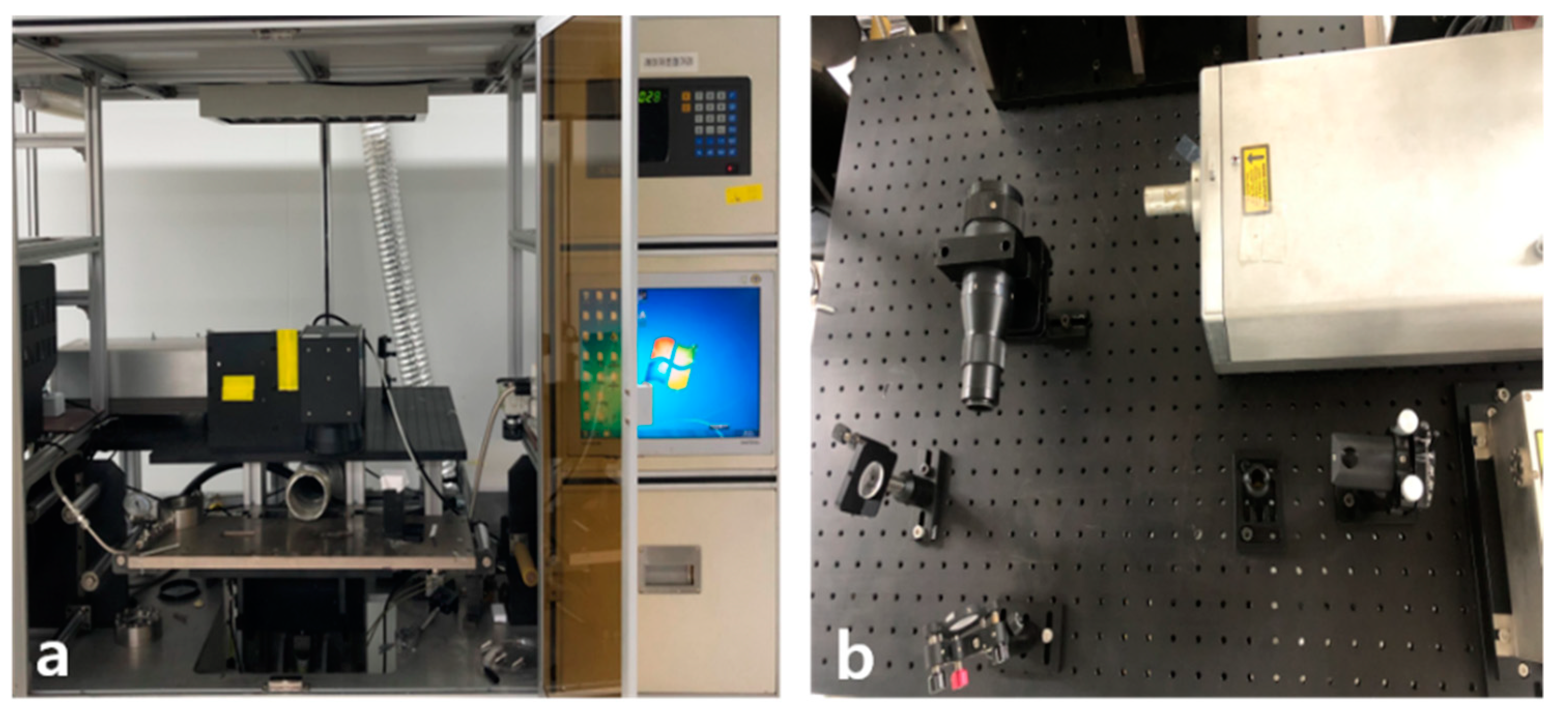
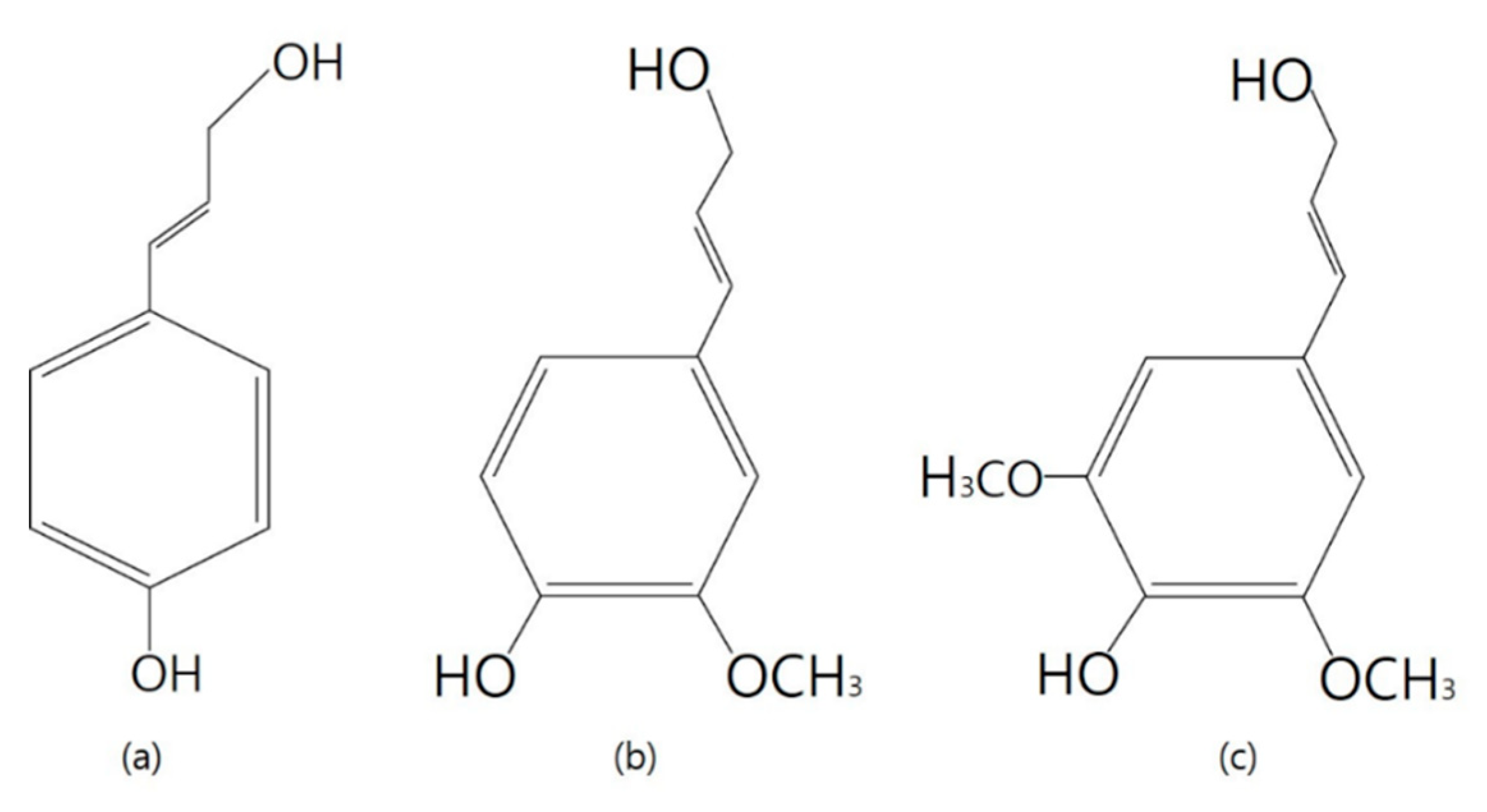


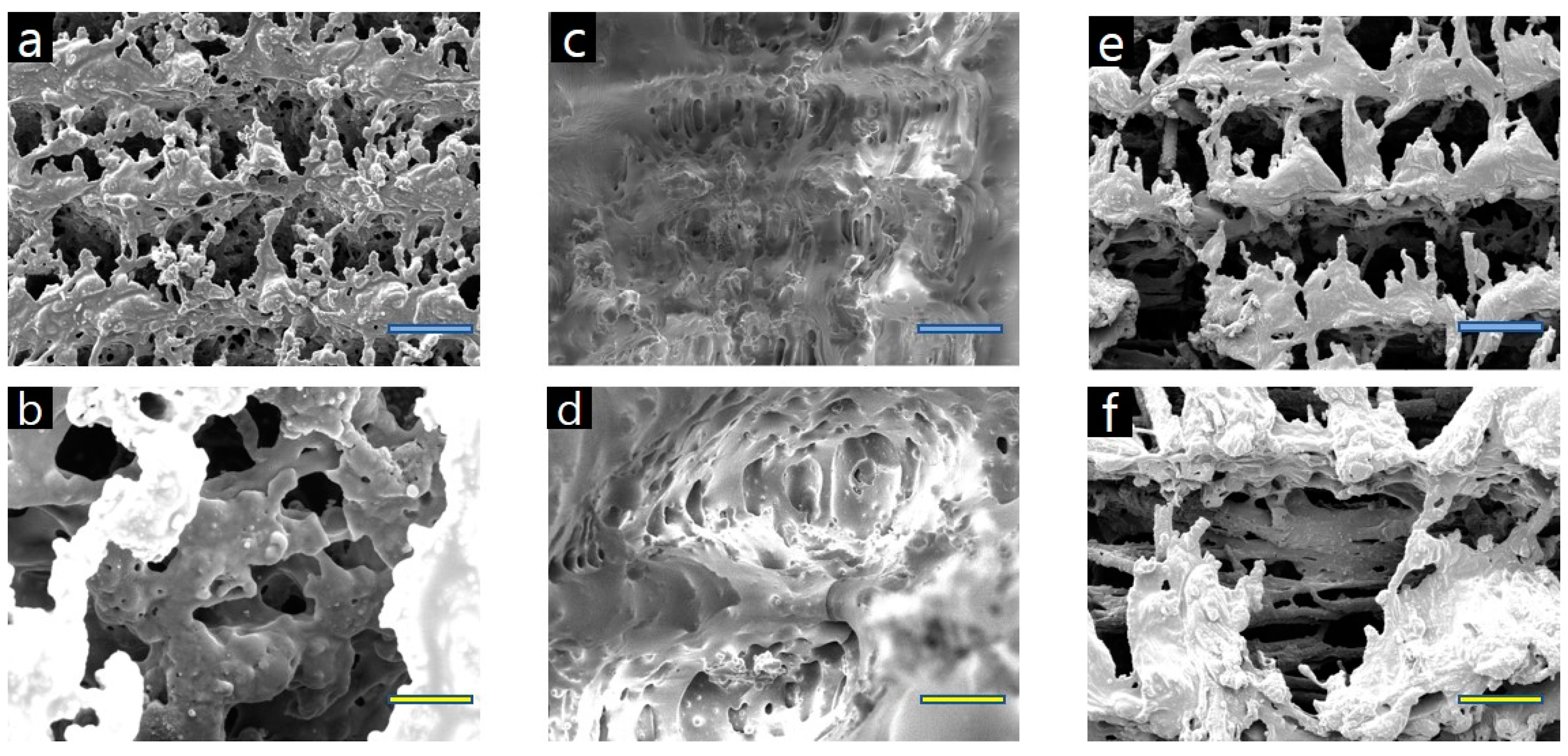
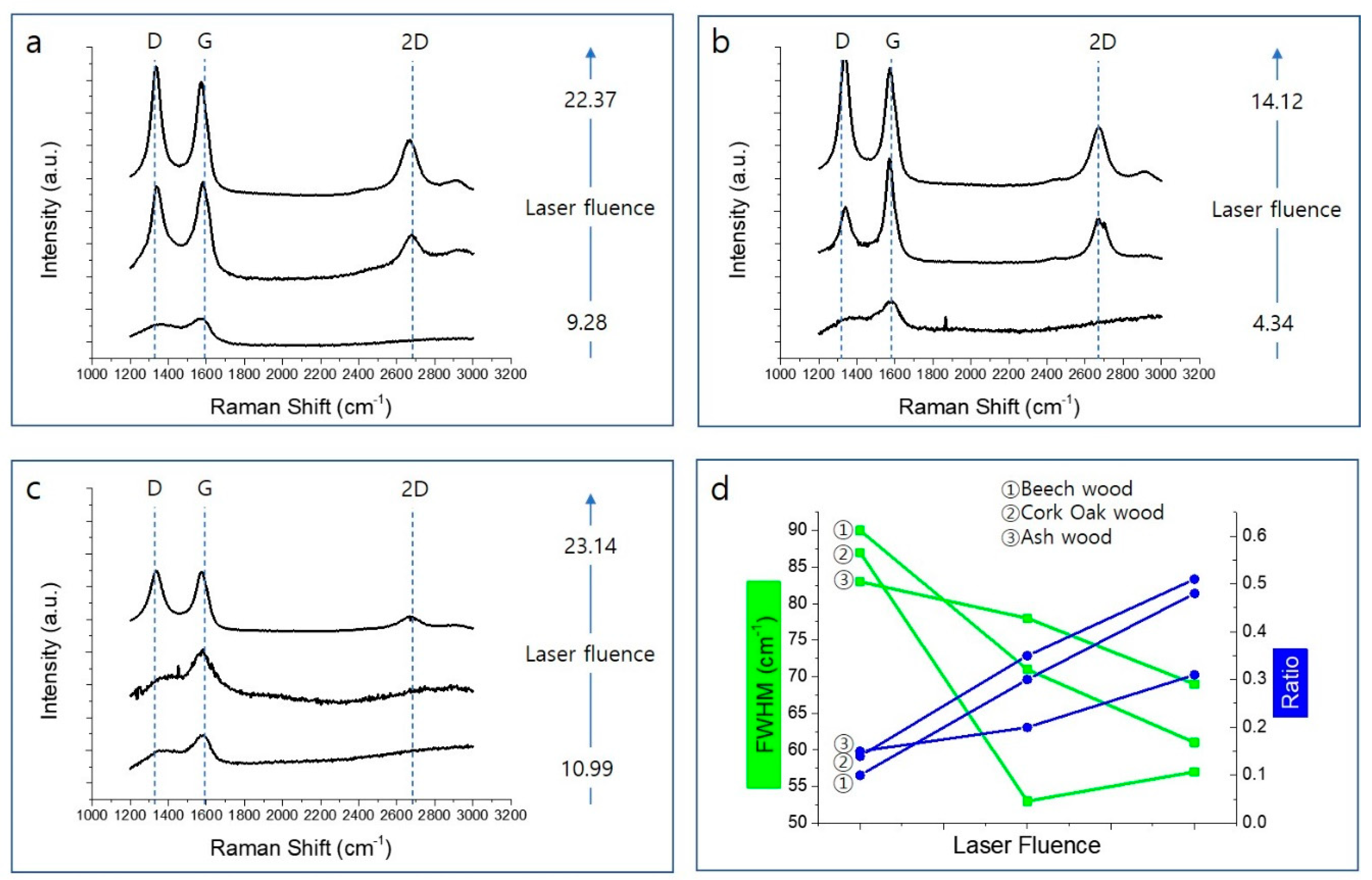
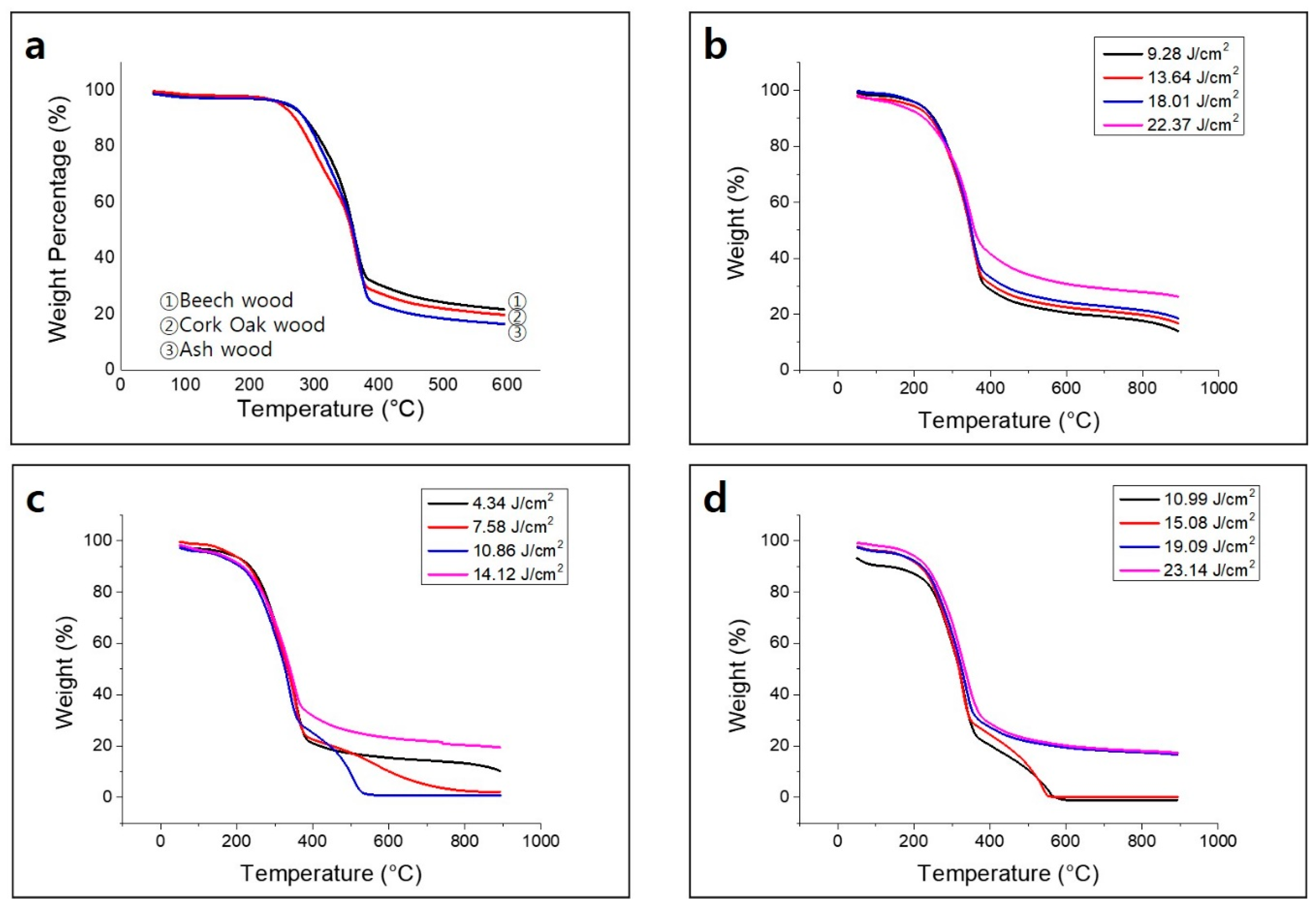

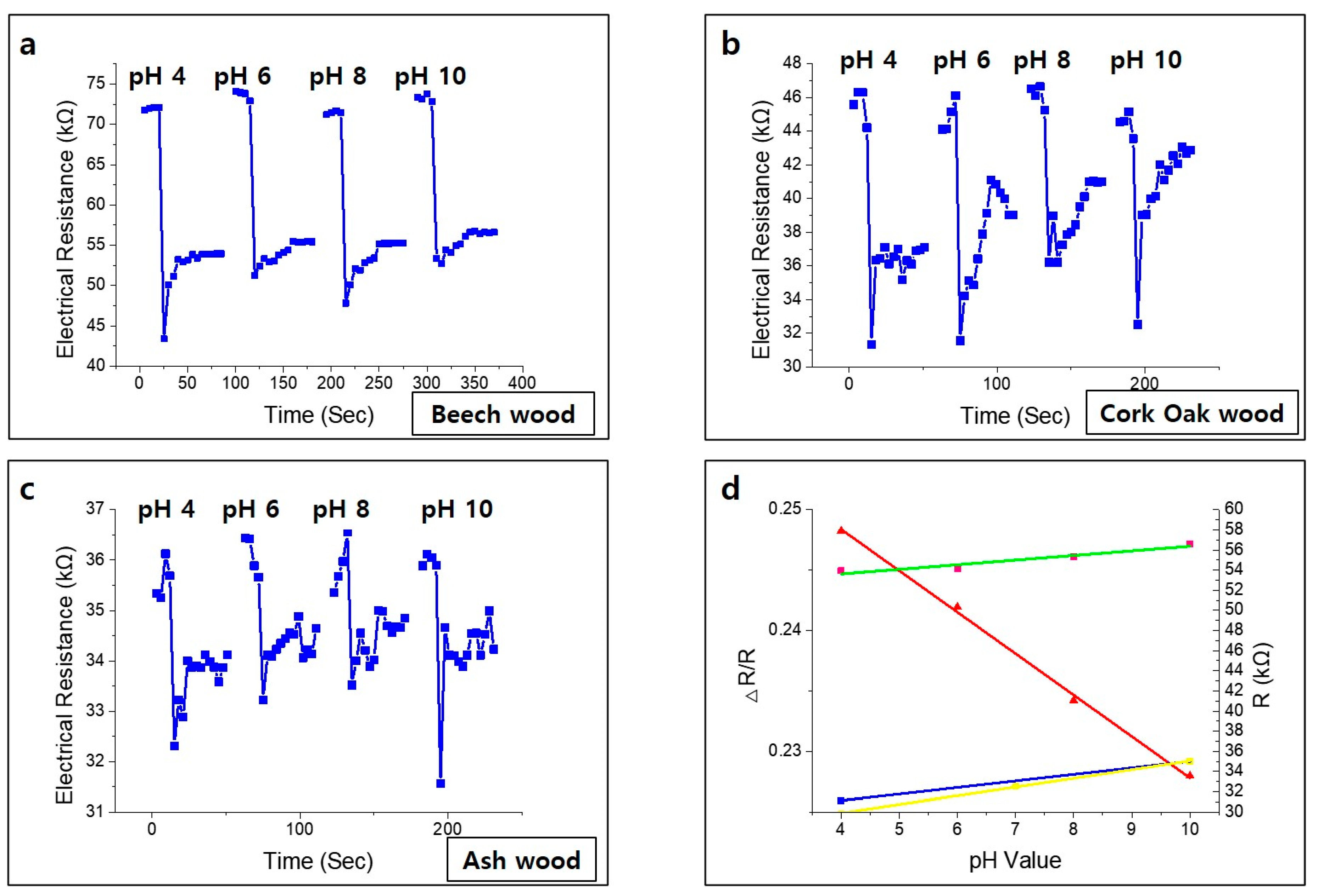

| Parameter | Value | Unit |
|---|---|---|
| Wavelength | 355 | nm |
| Average power | ~2.5 | Watt |
| Pulse length | 25 | nsec |
| Repetition rate | 30 | kHz |
© 2020 by the authors. Licensee MDPI, Basel, Switzerland. This article is an open access article distributed under the terms and conditions of the Creative Commons Attribution (CC BY) license (http://creativecommons.org/licenses/by/4.0/).
Share and Cite
Jeong, S.-Y.; Lee, C.-W.; Lee, J.-U.; Ma, Y.-W.; Shin, B.-S. Laser-Induced Biochar Formation through 355 nm Pulsed Laser Irradiation of Wood, and Application to Eco-Friendly pH Sensors. Nanomaterials 2020, 10, 1904. https://doi.org/10.3390/nano10101904
Jeong S-Y, Lee C-W, Lee J-U, Ma Y-W, Shin B-S. Laser-Induced Biochar Formation through 355 nm Pulsed Laser Irradiation of Wood, and Application to Eco-Friendly pH Sensors. Nanomaterials. 2020; 10(10):1904. https://doi.org/10.3390/nano10101904
Chicago/Turabian StyleJeong, Sung-Yeob, Chan-Woo Lee, Jun-Uk Lee, Yong-Won Ma, and Bo-Sung Shin. 2020. "Laser-Induced Biochar Formation through 355 nm Pulsed Laser Irradiation of Wood, and Application to Eco-Friendly pH Sensors" Nanomaterials 10, no. 10: 1904. https://doi.org/10.3390/nano10101904





